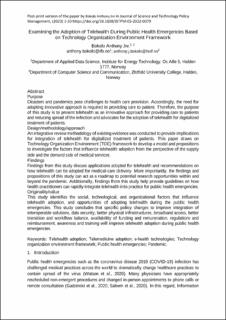| dc.contributor.author | Bokolo, Anthony Junior | |
| dc.date.accessioned | 2023-04-28T09:33:41Z | |
| dc.date.available | 2023-04-28T09:33:41Z | |
| dc.date.created | 2023-04-25T23:55:39Z | |
| dc.date.issued | 2023 | |
| dc.identifier.citation | Journal of Science and Technology Policy Management. 2023. | en_US |
| dc.identifier.issn | 2053-4620 | |
| dc.identifier.uri | https://hdl.handle.net/11250/3065475 | |
| dc.description.abstract | Purpose
Disasters and pandemics pose challenges to health-care provision. Accordingly, the need for adopting innovative approach is required in providing care to patient. Therefore, the purpose of this study is to present telehealth as an innovative approach for providing care to patients and reducing spread of the infection and advocates for the adoption of telehealth for digitalized treatment of patients.
Design/methodology/approach
An integrative review methodology of existing evidence was conducted to provide implications for integration of telehealth for digitalized treatment of patients. This paper draws on Technology Organization Environment (TOE) framework to develop a model and propositions to investigate the factors that influence telehealth adoption from the perspective of the supply side and the demand side of medical services.
Findings
Findings from this study discuss applications adopted for telehealth and recommendations on how telehealth can be adopted for medical-care delivery. More importantly, the findings and propositions of this study can act as a roadmap to potential research opportunities within and beyond the pandemic. In addition, findings from this study help provide guidelines on how health practitioners can rapidly integrate telehealth into practice for public health emergencies.
Originality/value
This study identifies the social, technological and organizational factors that influence telehealth adoption, and opportunities of adopting telehealth during the public health emergencies. This study concludes that specific policy changes to improve integration of interoperable solutions; data security; better physical infrastructures; broadband access; better transition and workflow balance; availability of funding and remuneration; regulations and reimbursement; awareness; and training will improve telehealth adoption during public health emergencies. | en_US |
| dc.language.iso | eng | en_US |
| dc.publisher | Emerald | en_US |
| dc.subject | telehealth adoption | en_US |
| dc.subject | telemedicine adoption | en_US |
| dc.subject | e-health technologies | en_US |
| dc.subject | technology organization environment framework | en_US |
| dc.subject | public health emergencies | en_US |
| dc.subject | pandemic | en_US |
| dc.title | Examining the adoption of telehealth during public health emergencies based on technology organization environment framework | en_US |
| dc.type | Peer reviewed | en_US |
| dc.type | Journal article | en_US |
| dc.description.version | acceptedVersion | en_US |
| dc.subject.nsi | VDP::Medisinske Fag: 700::Helsefag: 800::Helsetjeneste- og helseadministrasjonsforskning: 806 | en_US |
| dc.subject.nsi | VDP::Teknologi: 500::Informasjons- og kommunikasjonsteknologi: 550::Telekommunikasjon: 552 | en_US |
| dc.source.journal | Journal of Science and Technology Policy Management | en_US |
| dc.identifier.doi | 10.1108/JSTPM-05-2022-0079 | |
| dc.identifier.cristin | 2143345 | |
| cristin.ispublished | true | |
| cristin.fulltext | postprint | |
| cristin.qualitycode | 1 | |
